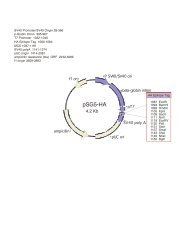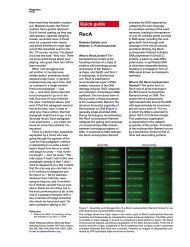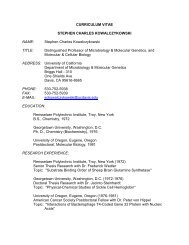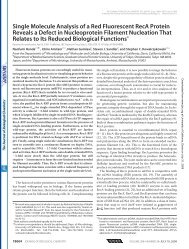Microtiter Plate Beta-Galactosidase Assay Protocol
Microtiter Plate Beta-Galactosidase Assay Protocol
Microtiter Plate Beta-Galactosidase Assay Protocol
Create successful ePaper yourself
Turn your PDF publications into a flip-book with our unique Google optimized e-Paper software.
<strong>Microtiter</strong> <strong>Plate</strong> <strong>Beta</strong>-<strong>Galactosidase</strong> <strong>Assay</strong> <strong>Protocol</strong><br />
Adapted by Vinh Pham from Michael Goodson, Ph.D protocols.<br />
Last modified: July 29, 2003.<br />
MATERIALS<br />
Wash Buffer (10mM Tris pH 7.5, 5mM DTT)<br />
Glass Beads (Ballotini Grade 8 –Jencons Scientific cat#136-015)<br />
To prepare: Soak in 1M HCl for 1hr, rinse by swirling twice in distilled water,<br />
and bake at 250ºC o/n.<br />
Z Buffer (60mM Na 2 HPO 4 , 40mM NaH 2 PO 4 , 10mM KCl, 1mM MgSO 4 , pH 7.0)<br />
0.5M Chlorophenol Red- _-D-Galactopyranoside (CPRG, Roche Biochemicals<br />
cat#0884308, 250mg)<br />
To prepare: Dissolve by adding 640ml dH 2 O to 250mg CPRG in original vial.<br />
Dilute 1-2ml CPRG in mfuge tubes with dH 2 O to a [10 -5 ].<br />
Measure A 420 . The desired A 420 range is 0.13 +/- 0.05. If needed,<br />
dilute CPRG in original vial with dH 2 O to attain this range.<br />
Recheck A 420 .<br />
Store in original vial at -20ºC<br />
96-well Clear, Flat-Bottom Polystyrene <strong>Microtiter</strong> <strong>Plate</strong> (Costar cat#9017)<br />
PROCEDURE<br />
Part I – Sample Preparation<br />
1. Grow yeast cells in 3-5ml of the appropriate Synthetic Complete (SC) medium (also<br />
known as Synthetic Dropout medium) to an OD 600 reading of at least 0.5 (aim for a<br />
range of 0.7-1.3 for consistency). For yeast 2-hybrid strains, use SC trp - leu - .<br />
Note: As a positive control, use strain KSC647, which contains plasmids with<br />
SNF1-Gal4 AD and SNF4-Gal4 BD fusion constructs originally made by Stephen J.<br />
Elledge, Ph.D. This strain was obtained from the Kaplan lab.<br />
2. Pellet at max speed for 1’.<br />
3. Wash 3 times with 1ml Wash Buffer.<br />
4. Resuspend pellet in 25-30ml Wash Buffer.<br />
5. Add approximately 1 volume of acid-washed glass beads.<br />
Note: Add beads to weighing paper, then transfer desired amount to a mfuge tube.<br />
6. Vortex on high for 1’.<br />
7. Incubate on ice for 1’.<br />
8. Repeat steps 6 & 7 four more times (for a total of 5 vortex/ice incubation steps).<br />
9. Pellet at max speed for 5”.<br />
10. Transfer s/n to a fresh mfuge tube.<br />
11. Add 2.5ml 3M KCl.<br />
12. Spin at max speed for 10’ at 4ºC.<br />
13. Transfer s/n to a fresh mfuge tube.<br />
14. Quick-freeze extracts with liquid nitrogen or a dry-ice ethanol bath.
15. Store at -20ºC or -80ºC.<br />
Note: A freeze or no freeze experiment showed that freezing the extracts does<br />
not adversely affect _-galactosidase activity.<br />
Part II – _-<strong>Galactosidase</strong> <strong>Assay</strong><br />
1. Set microplate reader temperature to 37ºC and allow to warm up for 10’.<br />
2. Prepare fresh <strong>Assay</strong> Substrate.<br />
Z Buffer 1000ml (5 samples) 6ml (30) 12ml (60)<br />
0.5M CPRG 1.0ml 6ml 12ml<br />
_-Mercaptoethanol (_-ME) 1.4ml 8.4ml 16.8ml<br />
Note: Do NOT allow more than the desired volume of CPRG to thaw. Scrape<br />
off the required amount and allow to thaw on side of tube before pipetting.<br />
3. (Optional) Warm <strong>Assay</strong> Substrate to 37ºC.<br />
4. Add 20ml sample/well to a microtiter plate (Unknowns). Use 20ml of Wash Buffer<br />
as a negative control (Blank).<br />
5. Load plate into reader (use “Drawer” button to open and close).<br />
6. Launch SOFTmax® Pro application.<br />
7. Under “<strong>Assay</strong>s” menu, select “CPRG(B galactosidase <strong>Assay</strong>).”<br />
8. Click “Setup” button and change the following readings, if needed:<br />
Mode: Kinetic<br />
Wavelength: 550nm<br />
Run Time: 1 hour Automix ÷ Before First Read: 5 secs<br />
Interval: 1 minute<br />
÷ Between Reads: 3 secs<br />
9. Click “Display” button, select “Plot” and check the “With reduced number” box.<br />
10. Click “Template” button.<br />
11. Select experimental sample fields and group as “Unknowns.”<br />
12. Place negative control field in “Blank” group.<br />
13. Click OK to close template.<br />
14. Click Read.<br />
15. While the plate is being read, measure [sample protein] by Bradford Protein <strong>Assay</strong><br />
using the remaining 5-10ml of sample.<br />
16. After 1 hour have elapsed, export file as a .txt file to ZIP disk.<br />
17. Open file in Microsoft Excel. The numbers at the bottom are the Vmax values for<br />
each sample (computed through a linear regression algorithm), which measure milli<br />
OD 550 units per minute. Each Vmax value is the slope of a particular plot, and it is<br />
proportional to the amount of product formed per unit time.<br />
18. Divide these readings by the [protein]’s from step 15 to get arbitrary _-<br />
galactosidase specific activity units (milli-OD 550 per min. per mg of protein).<br />
Disregard samples with OD 595 readings below 0.15.<br />
19. Display results in bar graph.











